Note
Go to the end to download the full example code
Visualize bundles and metrics on bundles#
First, let’s download some available datasets. Here we are using a dataset which provides metrics and bundles.
import numpy as np
from dipy.data import fetch_bundles_2_subjects, read_bundles_2_subjects
from dipy.tracking.streamline import length, transform_streamlines
from dipy.viz import actor, window
fetch_bundles_2_subjects()
dix = read_bundles_2_subjects(
subj_id="subj_1", metrics=["fa"], bundles=["cg.left", "cst.right"]
)
Store fractional anisotropy.
fa = dix["fa"]
Store grid to world transformation matrix.
affine = dix["affine"]
Store the cingulum bundle. A bundle is a list of streamlines.
bundle = dix["cg.left"]
It happened that this bundle is in world coordinates and therefore we need
to transform it into native image coordinates so that it is in the same
coordinate space as the fa image.
bundle_native = transform_streamlines(bundle, np.linalg.inv(affine))
Show every streamline with an orientation color#
This is the default option when you are using line or streamtube.
scene = window.Scene()
stream_actor = actor.line(bundle_native)
scene.set_camera(
position=(-176.42, 118.52, 128.20),
focal_point=(113.30, 128.31, 76.56),
view_up=(0.18, 0.00, 0.98),
)
scene.add(stream_actor)
# Uncomment the line below to show to display the window
# window.show(scene, size=(600, 600), reset_camera=False)
window.record(scene=scene, out_path="bundle1.png", size=(600, 600))
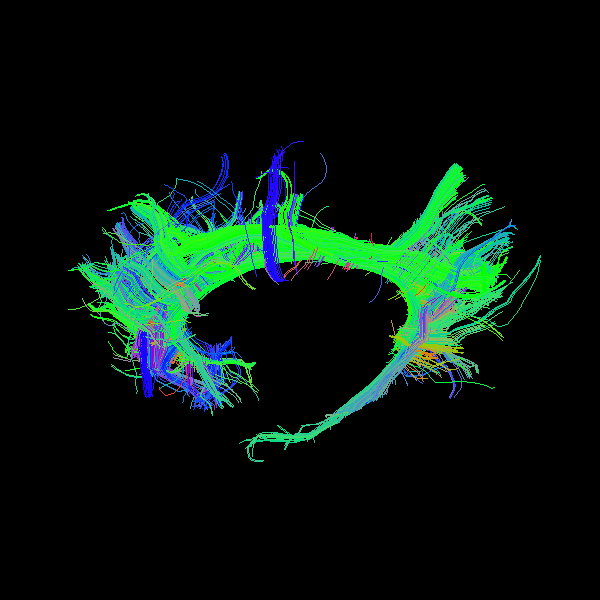
One orientation color for every streamline.
You may wonder how we knew how to set the camera. This is very easy. You just
need to run window.show once to see how you want to see the object and
then close the window and call the camera_info method which prints the
position, focal point and view up vectors of the camera.
scene.camera_info()
# Active Camera
Position (-237.76, 115.97, 138.55)
Focal Point (112.80, 127.81, 76.06)
View Up (0.18, 0.00, 0.98)
Show every point with a value from a volume with default colormap#
Here we will need to input the fa map in streamtube or line.
scene.clear()
stream_actor2 = actor.line(bundle_native, colors=fa, linewidth=0.1)
We can also show the scalar bar.
bar = actor.scalar_bar()
scene.add(stream_actor2)
scene.add(bar)
# window.show(scene, size=(600, 600), reset_camera=False)
window.record(scene=scene, out_path="bundle2.png", size=(600, 600))
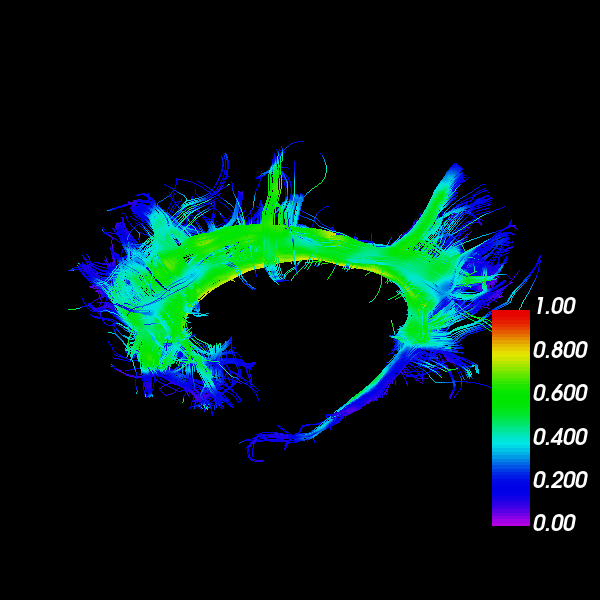
Every point with a color from FA.
Show every point with a value from a volume with your colormap#
Here we will need to input the fa map in streamtube
scene.clear()
hue = (0.0, 0.0) # red only
saturation = (0.0, 1.0) # white to red
lut_cmap = actor.colormap_lookup_table(hue_range=hue, saturation_range=saturation)
stream_actor3 = actor.line(
bundle_native, colors=fa, linewidth=0.1, lookup_colormap=lut_cmap
)
bar2 = actor.scalar_bar(lookup_table=lut_cmap)
scene.add(stream_actor3)
scene.add(bar2)
# window.show(scene, size=(600, 600), reset_camera=False)
window.record(scene=scene, out_path="bundle3.png", size=(600, 600))

Every point with a color from FA using a non default colormap.
Show every bundle with a specific color#
You can have a bundle with a specific color. In this example, we are choosing orange.
scene.clear()
stream_actor4 = actor.line(bundle_native, colors=(1.0, 0.5, 0), linewidth=0.1)
scene.add(stream_actor4)
# window.show(scene, size=(600, 600), reset_camera=False)
window.record(scene=scene, out_path="bundle4.png", size=(600, 600))
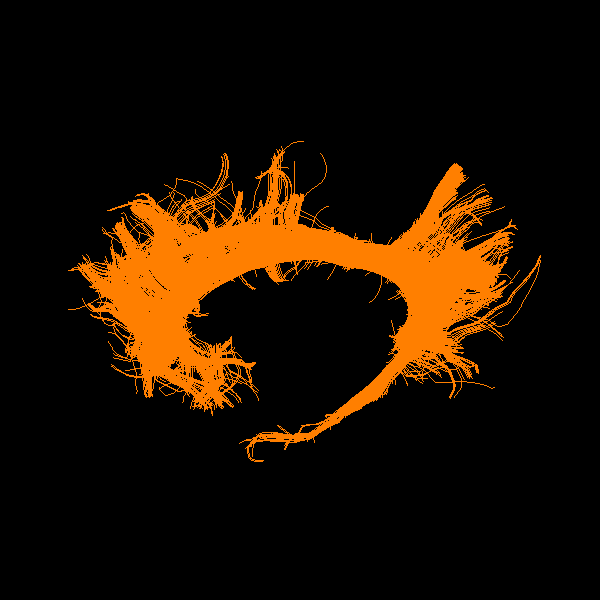
Entire bundle with a specific color.
Show every streamline of a bundle with a different color#
Let’s make a colormap where every streamline of the bundle is colored by its length.
scene.clear()
lengths = length(bundle_native)
hue = (0.5, 0.5) # blue only
saturation = (0.0, 1.0) # black to white
lut_cmap = actor.colormap_lookup_table(
scale_range=(lengths.min(), lengths.max()),
hue_range=hue,
saturation_range=saturation,
)
stream_actor5 = actor.line(
bundle_native, colors=lengths, linewidth=0.1, lookup_colormap=lut_cmap
)
scene.add(stream_actor5)
bar3 = actor.scalar_bar(lookup_table=lut_cmap)
scene.add(bar3)
# window.show(scene, size=(600, 600), reset_camera=False)
window.record(scene=scene, out_path="bundle5.png", size=(600, 600))
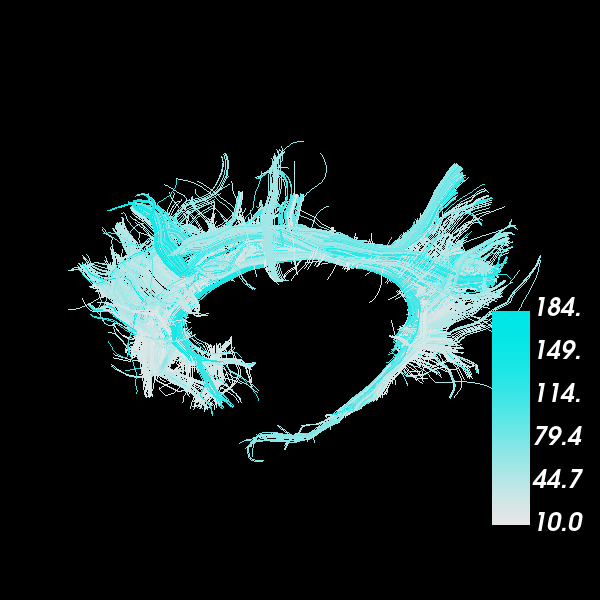
Color every streamline by the length of the streamline
Show every point of every streamline with a different color#
In this case in which we want to have a color per point and per streamline,
we can create a list of the colors to correspond to the list of streamlines
(bundles). Here in colors we will insert some random RGB colors.
scene.clear()
rng = np.random.default_rng()
colors = [rng.random(streamline.shape) for streamline in bundle_native]
stream_actor6 = actor.line(
bundle_native, colors=np.asarray(colors, dtype=object), linewidth=0.2
)
scene.add(stream_actor6)
# window.show(scene, size=(600, 600), reset_camera=False)
window.record(scene=scene, out_path="bundle6.png", size=(600, 600))
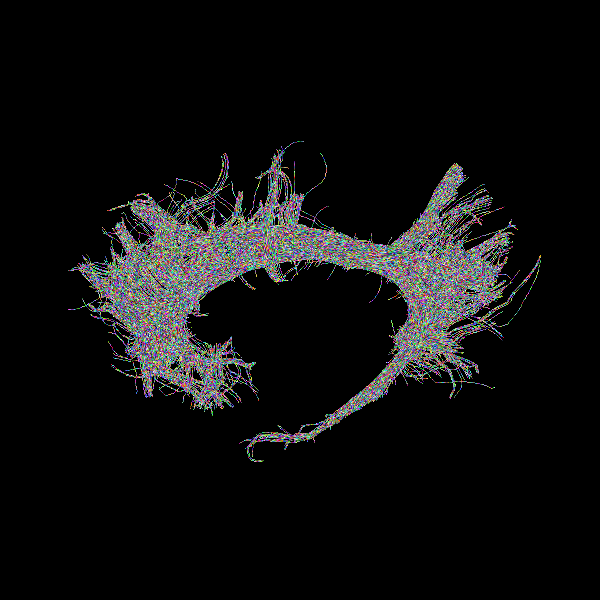
Random colors per point per streamline.
In summary, we showed that there are many useful ways for visualizing maps on bundles.
Total running time of the script: (0 minutes 7.737 seconds)